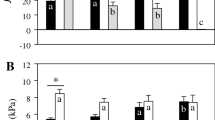Abstract
The beating activity of the molluscan heart is myogenic, but it is influenced by nervous signals of central origin. Previous studies have demonstrated changes in cardiac output during feeding and other behaviors. Here, we describe a short latency, transient cardiac response that accompanies withdrawal reflexes. When evoked by electrical stimulation of peripheral nerves, the response was detected within one or two heartbeats. Beat amplitudes increased on average 11.6%, and inter-beat intervals decreased on average 2.1%. The mean duration of the response was 28.1 s. A transient inhibitory phase often preceded the excitatory response. Results from testing various nerves and tissues show that the cardiac responses invariably occur whenever contractions of the tentacle retractor muscle are elicited. Even stimulation of the ovotestis and the kidney elicit responses despite their protected locations within the mantle cavity. Three excitatory cardioactive neurons are identified in the central nervous system of Helix aspersa, and their involvement in the reflex response is documented. The results suggest that the heart output is initially inhibited to relax the hydroskeleton and thereby aid withdrawal movements. A delayed increase in cardiac output then facilitates the re-inflation, hence eversion, of the withdrawn body parts.






Similar content being viewed by others
References
Antkowiak T, Chase R (2003) Sensory innervation of the ovotestis in the snail Helix aspersa. J Exp Biol 206:3913–3921
Balaban PM (1979) A system of command neurons in snail’s escape behavior. Acta Neurobiol Exp 39:97–107
Buckett KJ, Peters M, Benjamin PR (1990) Excitation and inhibition of the heart of the snail, Lymnaea, by non-FMRFamidergic motoneurons. J Neurophysiol 63:1436–1447
Casto R, Nguyen T, Printz MP (1989) Characterization of cardiovascular and behavioral responses to alerting stimuli in rats. Am J Physiol 256:R1121–R1126
Chase R (2002) Behavior and its neural control in gastropod molluscs. Oxford University Press, New York
Clark GA, Kandel ER (1984) Branch-specific heterosynaptic facilitation in Aplysia siphon sensory cells. Proc Natl Acad Sci USA 81:2577–2581
Davis M (1984) The mammalian startle response. In: Eaton RC (ed) Neural mechanisms of startle behavior. Plenum, New York, pp 287–351
Furukawa Y, Kobayashi M (1987) Neural control of heart beat in the African giant snail, Achatina fulica Férussac. I. Identification of the heart regulatory neurones. J Exp Biol 129:279–293
Holand S, Girard A, Laude D, Meyer-Bisch C, Elghozi J-L (1999) Effects of an auditory startle stimulus on blood pressure and heart rate in humans. J Hypertension 17:1893–1897
Kerkut GA, Lambert JDC, Gayton RJ, Loker JE, Walker RJ (1975) Mapping of nerve cells in the sub-esophageal ganglia of Helix aspersa. Comp Biochem Physiol 50A:1–25
Krontiris-Litowitz J (1999) Sensitizing stimulation causes a long-term increase in heart rate in Aplysia californica. J Comp Physiol A 185:181–186
Liebeswar G, Goldman JE, Koester J, Mayeri E (1975) Neural control of circulation in Aplysia. III. Neurotransmitters. J Neurophysiol 38:767–779
Martin KC, Casadio A, Zhu H, E Y, Rose JC, Chen M, Bailey CH, Kandel ER (1997) Synapse-specific, long-term facilitation of Aplysia sensory to motor synapses: a function for local protein synthesis in memory storage. Cell 91:927–938
Mayeri E, Koester J, Kupfermann I, Liebeswar G, Kandel ER (1974) Neural control of circulation in Aplysia. I. Motoneurons. J Neurophysiol 37:458–475
Prescott S, Chase R (1996) Two types of plasticity in the tentacle withdrawal reflex of Helix aspersa are dissociated by tissue location and response measure. J Comp Physiol A 179:407–414
Prescott SA, Gill N, Chase R (1997) The neural circuit mediating tentacle withdrawal in Helix aspersa, with specific reference to the competence of the motor neuron C3. J Neurophysiol 78:2951–2965
Rózsa KS (1987) Organization of the multifunctional neural network regulating visceral organs in Helix pomatia L. (Mollusca, Gastropoda). Experientia 43:965–972
Schmalz E (1914) Zur Morphologie des Nervensystems von Helix pomatia L. Z Wiss Zool 111:506–568
Skelton M, Alevizos A, Koester J (1992) Control of the cardiovascular system of Aplysia by identified neurons. Experientia 48:809–817
Walters ER (1991) A functional, cellular, and evolutionary model of nociceptive plasticity in Aplysia. Biol Bull 180:241–251
Zhuravlev VL, Safonova TA, Bychkov RE (1991) Neuronal control of coordination of the heartbeat in Helix pomatia. In: Sakharov DA, Winlow W (eds) Simpler nervous systems. Manchester University Press, Manchester, pp 342–359
Acknowledgements
We thank NSERC Canada for financial support. The experiments reported here comply with the laws of Canada and Quebec.
Author information
Authors and Affiliations
Corresponding author
Rights and permissions
About this article
Cite this article
Weatherill, D., Chase, R. Modulation of heart activity during withdrawal reflexes in the snail Helix aspersa. J Comp Physiol A 191, 355–362 (2005). https://doi.org/10.1007/s00359-004-0590-8
Received:
Revised:
Accepted:
Published:
Issue Date:
DOI: https://doi.org/10.1007/s00359-004-0590-8




